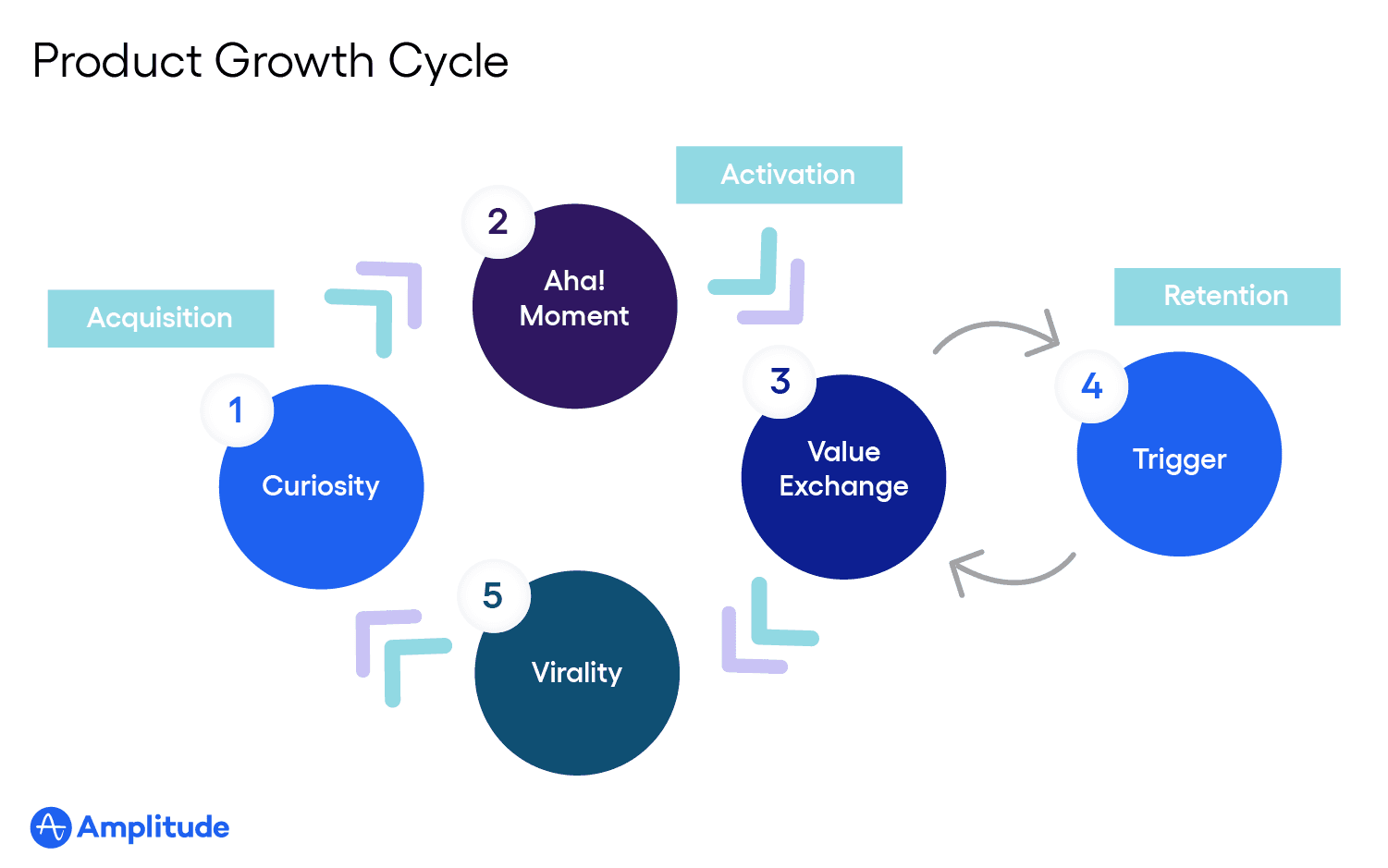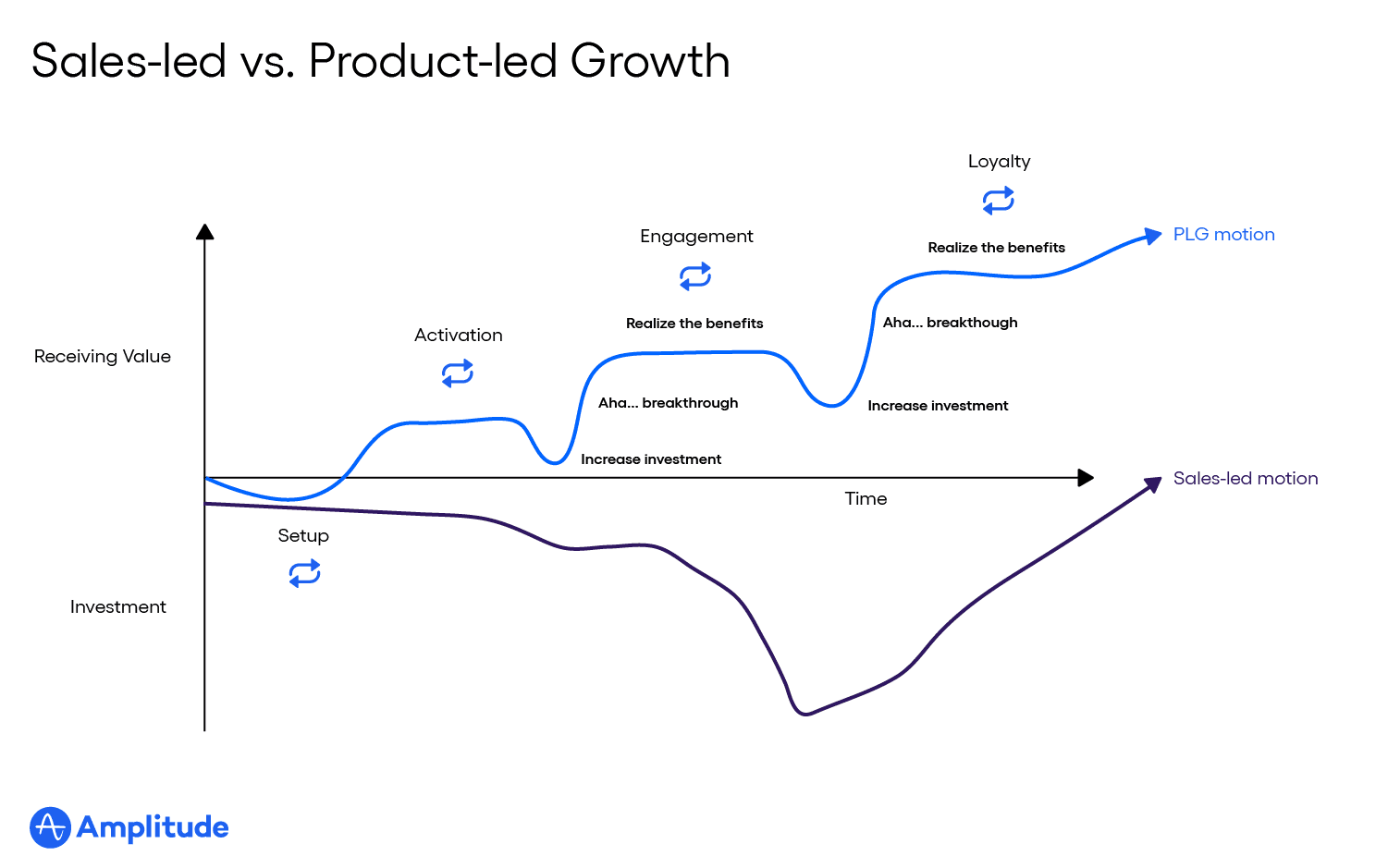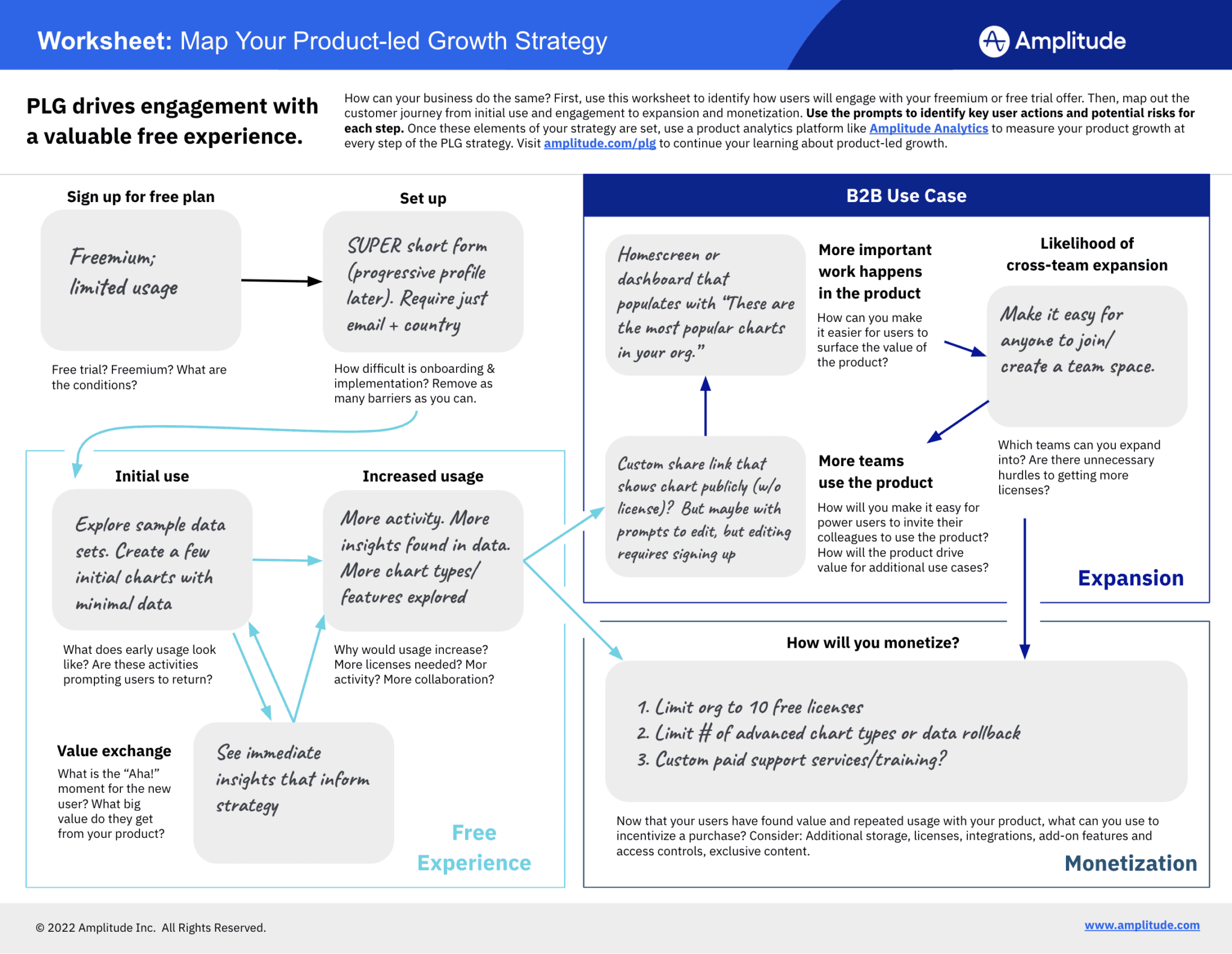What Is Product-Led Growth? Strategy, Metrics, & Examples
The increasingly popular go-to-market strategy seems to be everywhere these days. But what does "PLG" really mean? Here's your primer on the basics.
Originally Published on March 25, 2022
Browse by category
Product-led growth (PLG) is a business strategy and methodology that positions the product as the main driver of customer acquisition, activation, satisfaction, retention, and scalable expansion. When all the digital-facing teams across a company—marketing, product, customer success, and more—rally around product-led growth, the business is able to provide an innovative and personalized product experience that drives customer loyalty and retention.
At companies that are not product-led, the sales team may be the main revenue driver, with sales and customer success critical to driving retention. While this is still important at product-led companies, the key distinction is that at product-led companies, the product becomes a revenue and retention source of its own, driving deeper engagement with customers who find immense value in the top-tier product and keep coming back for more. The relationship with the customer strengthens and compounds over time—practically automatically, because the digital product experience generates customer loyalty on its own, without human intervention.
Key takeaways
- Product-led growth is an increasingly popular go-to-market strategy that aligns the entire business’s resources around providing the best experience possible.
- By adopting a product-led growth strategy, companies can scale faster and more efficiently while keeping costs low.
- The first step to becoming a product-led company is internal alignment around the metrics that drive sustainable growth, such as customer lifetime value, engagement, and retention.
- Companies such as Atlassian, Calendly, and Pinterest have leveraged PLG to drive compounding success and customer loyalty.
- Learn more about the fundamentals of product-led growth from 25 industry experts in Product-Led Growth Guide Volume 1: What Is PLG?
What does product-led growth look like in practice?
To make product-led growth a reality, the whole company must come together to rethink which metrics and tactics drive sustainable growth. In practice, this means that the way a company sells, markets, and retains customers goes through a transformation.
As a company or team leader, you must build the PLG “machine” around the product and get teams aligned on strategy. One way to set product-led growth into motion, for instance, is to provide a clear way for users to experience value from your product before they ultimately make a purchase. This way, the product itself becomes as much a sales function as your outbound sales team.
Product-led growth allows you to be more nimble with resources, too. Instead of throwing money at every new marketing and sales tactic, you can make a focused investment into your product. By prioritizing a best-in-class product experience, you don’t just keep customers coming back. You create a pipeline for new customer growth.
How does PLG compare to other growth models?
Product-led growth is a direct reaction to the more traditional models of the past. Salespeople or marketing materials have long been used to convince customers of the value of a product. PLG models focus on getting customers to discover that value themselves, often by letting them use the product before committing to a purchase.
Product-led growth encourages users to explore the product for free, with minimal barriers. As users gain value from the product, they’re more likely to share it with other team members and convert to a paid plan that offers more licenses and additional features. With this strategy, the product sells itself.
Companies typically employ one or a combination of the following growth models:
- Sales-led
- Marketing-led
- Product-led
The differences between the three models come down to internal alignment. Primarily sales-led companies are built to support the sales department as the primary source of revenue. Considerations from employee training to software purchases to marketing approaches are filtered through the lens of, “Does this help the sales team close more deals?”
The primarily marketing-led companies focus on convincing customers of a product’s value and appealing to customer needs. Again, the business is organized around supporting the marketing team in their efforts to appeal to customers and acquire leads. The sales team still has a role in closing deals, but it’s the marketing team’s customer research and advertising strategies that bring users into the fold. In a competitive space where products are very similar and difficult to distinguish, it can be the marketing efforts that make all the difference to pipeline and growth.
In both of these models, the prospect must be explicitly told the value of the product they’re considering. Product-led companies, on the other hand, prioritize letting the value of their product shine through. Instead of investing heavily into the outbound sales motion, for instance, the product-led companies may encourage prospects to engage with the product right away—in the form of a trial or “freemium“ subscription. Letting prospects use a well-built product ahead of purchase allows them to discover its benefits firsthand. An excellent product built with this mentality will reveal its true value to a customer—no persuasion needed.
Sales-led growth depends on a lot of upfront investments: building the sales team, developing sales collateral, investing time in lead qualification, and managing relationships. With product-led growth, results are more immediate, but still require an investment into figuring out what keeps users engaged.
Product-led companies focus on lowering customer acquisition cost (CAC) as much as possible. Hiring and training a massive sales team costs money. Quality digital and traditional marketing strategies also require sizable and consistent financial investments. That being said, becoming product-led doesn’t mean ditching traditional sales and marketing practices entirely. It’s more so about being strategic with your vision and investments.
At the end of the day, you still need a sales team to assist in selling and you still need a marketing team to generate demand. But product-led growth improves the efficacy of both sales-led and marketing-led practices. After all, it’s much easier to sell and market a product that customers love than it is to sell and market vaporware.
Learn more about how to combine the power of PLG with marketing and sales efforts in Product-Led Growth Guide Volume 1: What Is PLG?
Benefits of product-led growth
Product-led companies are known for creating high-quality products that deliver value to the end-user quickly and consistently. But there are more benefits outside of creating better products and making customers happy.
A product-led growth strategy should produce:
- Higher median enterprise value (EV): According to OpenView, “the median enterprise value (EV) of PLG companies is 2X higher than the public SaaS index as a whole.” This is because product-led companies design tools that alleviate the end-users’ problems. When done well, users stick around and even refer the product to others.
- Accelerated growth: OpenView also reports that PLG companies grow faster. The moment a PLG company achieves $10M in annual recurring revenue (ARR), they tend to expand and scale at a faster rate.
- Lower customer acquisition cost (CAC): Because most resources are funneled into the product, PLG companies aren’t limited by high marketing or sales costs. This enables them to stay in a healthy growth pattern with less time to see a return on the cost of acquisition.
How to become a product-led company
Any company that decides to fully adopt a product-led strategy will travel a unique path. Variations in industry, product, resources, talent, and maturity make it difficult to recommend a “one-size-fits-all” approach. That’s partly why at Amplitude, we recommend participating in a workshop with product-led experts like John Cutler to get started.
Before you attend a live event though, here are some basic steps to begin your product-led growth journey:
Ensure alignment across your organization
Internal alignment, starting at the executive level, is table stakes for adopting a PLG mindset. Becoming a product-led company isn’t possible if each team is aiming at a disparate goal. Resources and time must be concentrated and funneled into delivering a world-class product experience. This is about more than building the best product; it’s about designing the entire customer journey around a seamless experience. This involves every digital-facing team: marketing, customer success, analysts, and more. Product-led growth doesn’t just fall on the product team.
Learn how to set your environment and team up for PLG success in Product-Led Growth Guide Volume 1: What Is PLG?
Determine your product’s North Star
You can’t create the best product experience without understanding your end users. Identifying a North Star for your product will reveal the intersection of customer value and business value that your product provides. And setting focus with a North Star will help your product teams deliver on product improvements that actually make a difference—rather than becoming a feature factory.
Check out The North Star Playbook for guidance on how to get started.
Use behavioral analytics to measure and improve
Making data-driven decisions based on user behavior is critical to product-led growth. Behavioral analytics can track every interaction that occurs between your product and its users. Digital actions or events—such as abandoning a cart or skipping a song—reveal what your users find valuable and what they don’t.
In turn, behavioral product analytics will show you exactly how to improve the user journey, personalize the product experience, and introduce features users actually want. Marketing and customer success teams can use integrations to send messages to specific cohorts of users, too.
If your company is serious about product-led growth, investing in an event-based analytics platform is essential.
Product-led growth metrics
Product-led companies center their teams around the same product metrics and success indicators to align under the same agenda. Many are often standard metrics that are used in sales- and marketing-led environments. However, product-led companies tend to look at and use these metrics for different purposes than those models.
Acquisition
Monitoring how many prospects find your product and convert to users is crucial in any growth model. In the acquisition phase of the funnel, tracking indicators such as signups and qualified leads will help you identify opportunities and challenges with lead generation.
Lowering CAC is a central component of PLG models. The ultimate goal in a product-led company is getting CAC as close to zero as possible. Sales- and marketing-led companies also go to great lengths to minimize acquisition costs, but product-led businesses achieve more success by design.
Time-to-value (TTV)
Signing up a million prospects under free trials is incredible. It’s less incredible when only ten of them convert to paying subscribers. PLG models emphasizes creating an experience in which a customer discovers the value of a product as quickly as possible.
The time between signing up and discovering the usefulness of a product is called time-to-value (TTV). TTV is calculated by using product data to determine the average length of time it takes a customer to reach a critical activation event. A primary goal for a product-led company is decreasing the TTV rate to the lowest possible interval.
Retention
Sales and marketing-led approaches can sometimes fall into the trap of prioritizing acquisition over retention. The success of a marketing campaign is measured in leads generated, while the success of a sales team is calculated by their close rates. This creates a culture that often overemphasizes generating new customers versus delighting existing ones.
Product-led companies succeed based on the continued usage of a product by satisfied users. This places extra emphasis on retention efforts across teams and departments. Even if you convert all your freemium users to paid, it won’t matter unless they stick around. Monitoring the behaviors of your power users can help increase retention, and tracking churn can tip you off when something isn’t right.
Examples of product-led businesses
B2B and B2C companies have adopted product-led growth strategies with much success. Each company implements product-led strategies in different ways, but there are similar characteristics that are often noticeable.
Atlassian
Software development giant Atlassian has perfected the “bottom-up” product-led growth model. At the time of writing, the company is valued more than $100 billion USD. However, their investment in traditional sales and marketing strategies make up only a fraction of what one would expect for a company their size.
Instead, Atlassian leans into PLG tactics for continued success. They believe in simplifying the customer’s buying journey with helpful resources and a transparent pricing plan. Minimizing friction during this journey removes barriers to a customer jumping in and sampling the product, allowing them to quickly see the value in continued use.
Calendly
Founded in 2013, Calendly has become the go-to scheduling product that makes collaboration a breeze. Calendly is experiencing continued success because of a core PLG tenet: create an easy-to-use product that effectively solves a common problem. Calendly also discovered an everlasting lead generation tactic—invitees who don’t know about the tool get to try it for free without any obligation.
In an interview with UserVoice, Pinterest Engineering Manager John Egan attributes much of the company’s success to internal collaboration and executive alignment. “To be most effective, Growth teams need to be full-stack teams capable of implementing any feature they want themselves, without having to get support from another team.” Creating this kind of autonomy is dependent on executive leaders who adopt a PLG mindset.
Embarking on a PLG strategy
Companies looking to shift to a product-led model of growth face the unenvious task of reorienting their business infrastructure around their product. Luckily, there are resources to help you get started. Read up on strategies like The North Star Framework, Mastering Retention with your product, and how to identify the virtuous growth loops—aka flywheels—that already exist within your product.
You can also read Product-Led Growth Guide Volume 1: What Is PLG? or use Amplitude’s Product-Led Growth Worksheet to map out your own strategy:
And of course, to engage with a real example of product-led growth, check out the Amplitude starter plan. It’s our way of giving you the chance to:
- Manage robust data
- Track user behavior
- Personalize marketing messages
- A/B test product experiences
- Enhance the overall user experience
All without committing to a purchase. PLG, in a nutshell.
References
- 5 Diagrams That Explain Product-led Growth
- US adults added 1 hour of digital time in 2020 (Jan. 2021) eMarketer
- Freemium (Dec. 2021) Investopedia
- Product-led growth OpenView
- Expansion SaaS Benchmarks (2020) OpenView
- A Guide to SaaS Pricing Strategy: Models, Challenges, and Key Considerations (Jan. 2022) Mosaic
- Slack Statistics, User Counts, Facts & News (Oct. 2021) Expanded Ramblings
- The Secrets Behind Pinterest’s Outrageous Growth: An Interview UserVoice

Mallory Busch
Former Senior Content Marketing Manager, Amplitude
Mallory Busch formerly ran the Amplitude blog, frequently named a best blog for product managers. She also created AmpliTour, the live workshop for beginners to product analytics and 6 Clicks, the Amplitude video series. She produced the Flywheels Playbook, wrote The Product Report 2021 and produced The Product Report 2022. A former developer and journalist, Mallory's written work and coding projects have been published by TIME, Chicago Tribune, and The Texas Tribune. She graduated from Northwestern University.
More from Mallory








